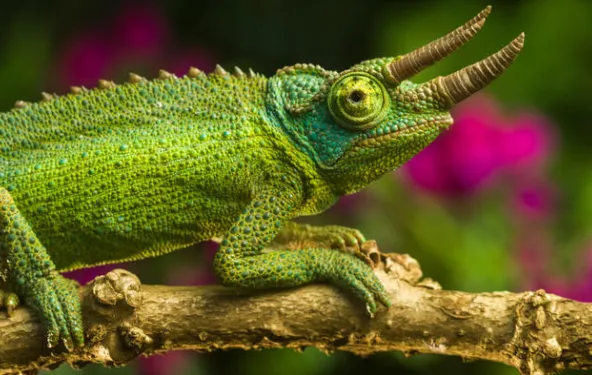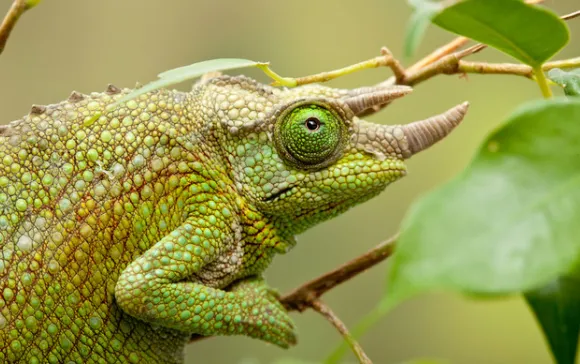
Table of Contents
Scientific Classification
- Kingdom: Animalia
- Phylum: Chordata
- Class: Reptilia
- Order: Squamata
- Suborder: Iguania
- Family: Chamaeleonidae
- Genus: Trioceros
- Species: T. jacksonii
Quick Overview
The Jackson’s Chameleon (Trioceros jacksonii) is renowned for its three distinctive horns, earning it the moniker “three-horned chameleon.” Hailing from East Africa, its unique appearance has endeared it to pet enthusiasts globally.
Fast Facts
- Scientific Name: “Trioceros jacksonii”
- Lifespan: 5-10 years in captivity
- Average Size: 8-12 inches
- Diet: Insectivorous
- Habitat: Forests and shrublands in parts of East Africa
Did you know?
Male Jackson’s Chameleons boast three prominent horns reminiscent of the triceratops. In contrast, females either lack these horns or have much smaller ones.
Appearance
While green is their predominant hue, Jackson’s Chameleons can adjust their color in response to mood, health, or external temperatures. The males sport three noticeable horns – a nasal one flanked by two brow horns, which play a role during confrontations with rival males.
Size and Weight
Jackson’s Chameleons typically span 8 to 12 inches. Their weight usually aligns with this size range.
Temperament and Behavior
Inherently solitary, Jackson’s Chameleons might exhibit aggressive behavior towards their own kind, especially within confined spaces. Their color shifts, besides being a spectacle, often communicate their emotional states.
Fun Fact:
Specially adapted feet, with two toes pointing forward and two backward, make them adept branch grippers.
Habitat and Distribution
Endemic to the forests and shrublands of Kenya and Tanzania, they’ve also been introduced to regions like Hawaii and some parts of the mainland USA, primarily due to the pet trade.
Care Guide
For Chameleon enthusiasts:
- A tall cage laden with plants and branches is recommended.
- Humidity should hover between 50-80%.
- UVB lighting, crucial for calcium metabolism, must be ensured.
- Daytime temperatures should remain within the 70-80°F range.
- Misting helps in keeping them hydrated.

Diet and Nutrition
Primarily insectivores, their diet centers around crickets, worms, and other small insects. Regular calcium and vitamin supplements further bolster their health.
Health and Wellness
A lack of proper UVB lighting can predispose them to metabolic bone disease. Adequate hydration is paramount to ward off renal complications.
Breeding
Jackson’s Chameleons are ovoviviparous. Females, after mating, can store sperm and produce several broods without remating. They give birth to 8-30 live young following a gestation of approximately 5-7 months.
Conservation Status
While they’re not on the brink of extinction, habitat encroachment and the exotic pet trade are impacting their natural numbers.
Fun Fact:
Standing apart from many chameleons, Jackson’s Chameleons bear live young rather than laying eggs.
Related Profiles
Share This Profile:
3 Amazing Facts About Jackson’s Chameleon
- 360° Vision: Each of the chameleon’s eyes can pivot independently, giving them a nearly complete arc of vision around their body – a valuable skill for detecting both predators and prey.
- Horned Combat: During territorial disputes, males employ their horns, often trying to push adversaries off perches.
- Thermal Regulators: Beyond mood display, their color transformations help modulate body temperature. Darker shades help in absorbing more sunlight.
- Enchi Ball Python: A Unique and Stunning Morph of Python regius - March 27, 2025
- Emerald Tree Monitor: The Enigmatic Green Guardian of the Rainforest - March 26, 2025
- The Egyptian Cobra (Naja haje): A Fascinating Serpent - March 25, 2025
